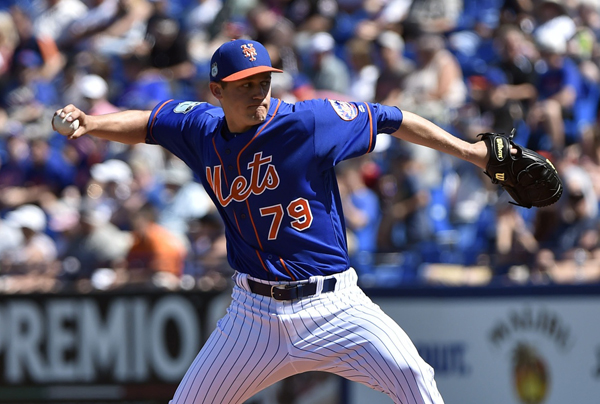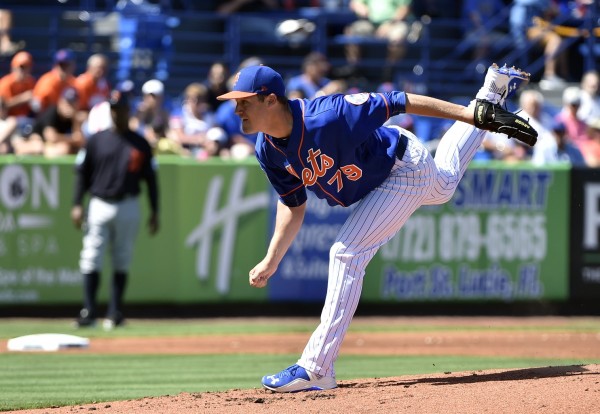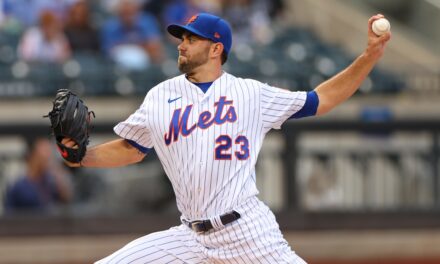
He is doing what he always does, what has elevated his professional baseball game from one level to the next. Paul Sewald is throwing strikes.
From his earlier times on the pitching mound Sewald has understood the value of throwing strikes. Like he has over his minor league career, this spring he is using his command of the strike zone to build a strong case that he should be included among a cadre of relief pitchers that inhabit the bullpen for the home team at Citi Field. At the very least, Sewald has captured the attention of New York Met manager Terry Collins and his pitching coach Dan Warthen, accruing chips that he might cash in as the season progresses.
Paul Sewald’s fastball may not sizzle and crackle with the same electric power of other professional baseball pitchers. His curveball may not have the dramatic bite and drop of other professional baseball pitchers. But, he understands that success on the pitcher’s mound comes from finding certain things to maximize an advantage. And, experience has taught Seward the simplest way to gain that edge is by throwing strikes.
Sewald, 26, has been nothing short of brilliant for the Mets in Florida this spring. In 9 appearances, the 6’3” right-hander has pitched 9.1 innings allowing just 1 run, a solo home run. That’s good for a sparkling 0.96 ERA. Even more impressive is Sewald’s WHIP, that’s walks and hits allowed per innings pitched. The Mets hopeful has yielded only three hits while walking three and striking out five for a WHIP of 0.64. His impressive spring has placed him in the conversation whenever Terry Collins talks to reporters about the possible configuration of his bullpen.
I enjoyed watching Sewald pitch in Binghamton two summers ago. Called on to take on the role as the B-Met closer in late spring, Sewald made good on 24 of 25 save opportunities. The B-Met relief pitching specialist used pinpoint control as the ace up his sleeve allowing just 10 base-on-balls in 51.1 innings with an ERA of 1.75 and a minuscule WHIP of only 0.861.
Sewald was also a guest on my Tip-Off sports radio show that summer. He was delightful. A product of a baseball family, (his younger brother Johnny is an outfielder in the Houston Astros farm system and has stolen 70 bases in the past three seasons), Sewald was emphatic in that interview about the importance of throwing strikes, saying that the ability to throw strikes is the most important part of pitching.
“If you walk a batter, you have a zero percent chance of getting them out. You’ve handed a hitter a free opportunity to get on base,” Sewald explained with passion.
“If you watch batting practice, they throw the ball right down the middle at 72 miles per hour every single time and the batter knows what’s coming and they know where it is coming and they still hit the ball for outs. So, why wouldn’t I throw the ball in the strike zone and make a hitter prove that he can get a hit?”

“The best hitters in baseball make outs 7 out of 10 times. Those are pretty good odds if I’m on the mound. I want to make hitters prove they can get a hit. I don’t know if you’ve stood in the batter’s box and tried to hit a 90 mph fastball. It’s not easy, so why wouldn’t I try to throw the ball over the plate and get outs?”
Sewald shared a relief pitching philosophy that day that didn’t vary regardless of the inning that he got the call to enter the game. “The most important thing is to make sure no runs get on the board. If it’s the ninth inning and I’m pitching for a save or its the sixth inning and I’m pitching for a single out, my focus is getting the next guy out.”
“As a relief pitcher your job is to come in, throw strikes, get quick outs and make sure no runs cross. So, I try not to think about if it’s a closer’s spot versus the set-up guy. I try to make the best pitch I can to every single hitter and try to get quick outs so I’m ready to go the next day, if they need me. For me, no matter what the situation, it’s about making the best pitch, getting the quick out, and if that’s at the end of the game when I’m done, then that’s the end of the game.”
I joked with Sewald on the air that day telling him that I sit a few rows behind home plate in NYSEG Stadium and my up close examination of his pitching delivery reminded me of Met pitching legend Tom Seaver. We talked about the different pitching styles, the ‘tall and fall’ style that dominates the current game and the ‘drop and drive’ deliveries of pitchers of yesteryear. Like Seaver, Sewald’s delivery was of the ‘drop and drive’ variety. The young pitcher told me that when he was in pitching at Arizona State someone compared his delivery to Seavers so he went to the library, found film and watched Seaver pitch.
Here’s what Sewald told me about his research:
“Don’t get me wrong, i don’t throw 97 miles per hour like Seaver. But, watching the film of Seaver I can understand how people might think my delivery is like the drop and drive style that a lot of guys from that era used. I use it to my advantage. It’s very deceptive. I step across my body, and have a low three-quarter arm angle. It can be very difficult for hitters to pick up the ball. I don’t throw 94-95 mph. I throw in the low 90’s. I have to throw the ball at the knees and in and out to the edges of the plate.”
Sewald uses both a four and two seam fastball that he likes to throw to both sides of the plate. He considers his slider as his best pitch. “I’ve gotten good enough where I can maneuver it into something that looks like a curve and something that looks more like a cutter. I use that against both lefties and righties. Seward’s change-up is his most recent addition to his pitching arsenal another weapon to add to his mound value.
Paul Sewald is a bright, articulate, and very socially gifted guy. My Sewald interview was an all time favorite. That’s why I’m pulling hard for the kid to prove that in the long run, hard work and consistency pays dividends. I’m hoping he gets the call with a shot to pitch in the Mets bullpen sometime this year. Command, location and pitching makeup on the mound are the Pitching Trifecta. That’s Paul Seward’s formula for pitching success.















